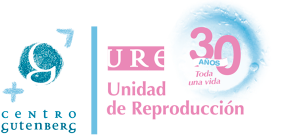Azoospermia and assisted reproduction

Male infertility represents 40% of infertility cases that look to assisted reproduction clinics, such as our fertility clinic in Spain, for help. And, of these cases, 15% have azoospermia.
Azoospermia is a semen abnormality characterised by the total absence of spermatozoids in the ejaculate. This absence of sperm may occur if the testicles do not secrete spermatozoids (non-obstructive azoospermia), or if the testicles do produce sperm but none are present in the ejaculate due to an obstruction (obstructive azoospermia).
In this article we want to tell you how we diagnose each of these types of azoospermia in assisted reproduction clinics, as well as what treatments exist in order to achieve a pregnancy and prevent this male infertility issue.
Obstructive azoospermia
Obstructive azoospermia is the absence of spermatozoids in semen due to a defect in the seminiferous tubules or vas deferens, thus preventing the sperm from exiting the body as part of the ejaculate.
With this type of azoospermia, testicular functioning and production is normal. This is characteristic of illnesses such as cystic fibrosis, infections of the seminal conducts or following a surgery, such as a vasectomy (male surgical sterilisation).
Non‐obstructive azoospermia
Non‐obstructive azoospermia is more serious, as it involves a defect in the process of sperm cell formation (spermatogenesis). This type of azoospermia is the most common, representing 70% of azoospermia cases.
Non‐obstructive azoospermia may be congenital (present at birth), or acquired at a certain point in time during the male’s life (testicular trauma, hormonal imbalance, illnesses such as the mumps and meningitis, radiotherapy and chemotherapy, use of certain medications or drugs, etc.).
Additionally, with non‐obstructive azoospermia the absence of sperm production in the testicles may be total and absolute, partial or focal.
Diagnosing azoospermia
In the event that a semen analysis indicates a total absence of spermatozoids, it is recommended that the male have the sperm study carried out a second time to confirm the diagnosis. These tests should be done at least a week apart.
In addition to the semen analysis, the patient should provide his complete medical record: any family or personal history, use of medication at present, drug consumption, etc. By drawing a blood sample we will also run a male hormone study, genetic study (karyotype, Y chromosome microdeletion, cystic fibrosis …) and a physical examination of his genitals. The results of these tests are generally able to pinpoint a possible cause of the patient’s azoospermia.
To obtain a definitive diagnosis, however, a testicular biopsy is often necessary. The purpose of this procedure is not only to determine the cause of azoospermia, but also to freeze any sperm recovered so that it can later be used in a cycle of in vitro fertilisation.
Treatment for azoospermia
When we are dealing with obstructive azoospermia, the treatment needed to achieve a pregnancy is in vitro fertilisation with ICSI. In this case, the necessary spermatozoids will be obtained by testicular biopsy.
In the case of non‐obstructive azoospermia, treatment shall depend on the nature of the condition, and there are two alternatives:
- With complete non‐obstructive azoospermia, the only possible treatment to achieve fatherhood is to use spermatozoids from a sperm donor bank.
- Azoospermia which is acquired through infection or due to the use of medication/drugs, etc., may be treated to recover spermatogenesis or sperm formation; following treatment, the female may even be able to get pregnant naturally.
Testicular biopsy in cases of azoospermia
The testicular biopsy, just like egg retrieval, is performed in the operating theatre and the patient is generally sedated. This intervention lasts between 15 and 20 minutes approximately and is carried out by a urologist or a fertility specialist.
During the testicular biopsy the physician will make a small incision on the scrotum and the testicle, measuring about two centimetres wide, and will extract a small sample of testicular tissue. This is the sample that the biologist will analyse to confirm or rule out the presence of spermatozoids.
If spermatozoids are found, they will be used in a fresh cycle of in vitro fertilisation, or they can also be cryo‑preserved in a sperm bank and used later in a cycle of assisted reproduction. Generally speaking, a sample is also sent off to be studied for anatomic pathology, which will help to make the diagnosis.
Following the testicular biopsy the male will need time to recover and remain under observation for about two hours, after which he will be discharged and can go home.
Like with all surgical interventions the testicular biopsy is not completely risk‑free, but the risks are highly controlled and complications are very infrequent.
Do you think you may have azoospermia and would you like to be diagnosed? At our fertility clinic in Spain we can help you. Schedule an appointment with us and we’ll review your case and find the best solution so that you can become a father.

